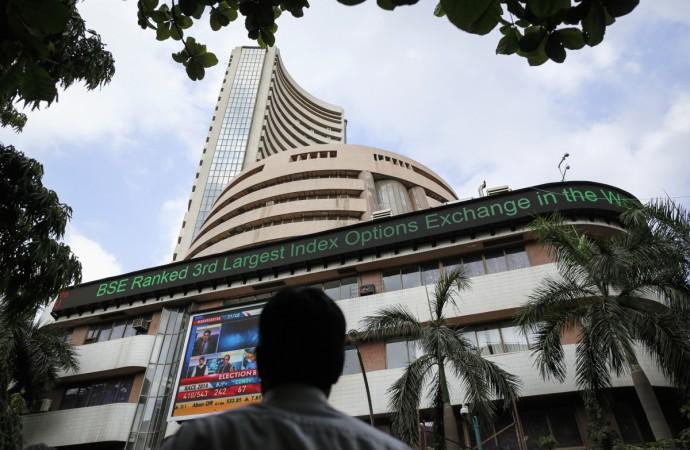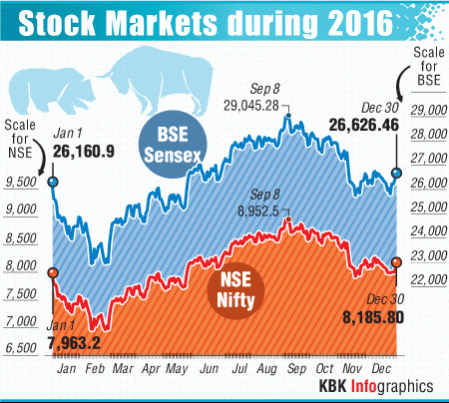
The BSE Sensex and NSE Nifty — India's benchmark stock market indices ended calendar year 2017 trading with gains of 1.94 percent and 3 percent, respectively. On Friday (December 30), the Sensex closed 260 points higher at 26,626, while the 50-scrip Nifty ended with gains of 82 points at 8,1,86.
Read: Urge Indians to do 5 transactions through BHIM app till Jan 1: Modi at Digi-Dhan Mela
On December 31, 2015, the Sensex rose 157 points to close at 26,117 while the NSE Nifty was up 50 points to end at 7,946.
The 1.94 percent and 3 percent gain for Sensex and Nifty respectively is a reversal of sorts, considering the indices had lost 5 percent and 4 percent in calendar year 2015.
The year also saw change of guard at the Reserve Bank of India, with Raghuram Rajan paving the way for Urjit Patel's elevation as the governor.
Year of surprises
For the stock markets, there were many negative surprises such as Brexit, Donald Trump's surprise victory in the US presidential elections, interest rate hike by the US Fed and last but not the least, demonetisation decision announced by PM Narendra Modi on November 8, 2016.
A minor setback to stock markets was also witnessed after the DGMO of the Indian Army briefed the media about surgical strike on terror launchpads located along the LoC in Pakistan-occupied Kashmir, on September 29, 2016.
"This year, the performance of the markets has remained lacklustre as a host of events brought high volatility in the markets. The gains recorded by the markets until September were completely erased by the outcome of the US election and government whip on black money through demonetisation. This also impacted the positive sentiment created by this year's normal monsoon and 7th pay commission payout," Angel Broking had said in its note a few days ago.
Bank stocks outperformed the Sensex, with the sectoral BSE Bankex index closing with gains of 7.34 percent (20,748 on December 30, 2016 and 19,328 on December 31, 2015).
The IT index on the BSE ended in the red, though it gained 1.09 percent on Friday.
Rupee closes with losses
The Indian rupee was also a victim of the global and domestic headwinds, losing 2.67 percent during the year to close at 67.93 to the US dollar on December 30 in comparison to 66.16 closing on December 31, 2015. Factors that impacted the domestic currency included redemption of FCNR deposits of 2013, in addition to persistent selling by FPIs, especially in the second half of the year.
Stock market outlook, triggers for 2017
Investors would be cautious in the initial weeks and wait for signals from the Budget 2017, especially in direct taxes (personal and corporate tax rates) since the scope for tweaking indirect taxes is limited in view of the Goods and Services Tax (GST).
The first major signal could as early as on January 2 on Lucknow where Prime Minister Narendra Modi is scheduled to address BJP workers at a rally, months before the upcoming Uttar Pradesh Assembly elections.
The second big trigger would of course be Budget 2017 likely to be presented on February 1 by finance minister Arun Jaitley. The Economic Survey that precedes would give some pointers on the macroeconomic scenario.
"Going ahead, we still see the demonetisation impact to keep hovering on the market gains even as the disruption caused to the Indian economy is likely to take two to three quarters to turn back. We are building high expectations from the upcoming union budget 2017-18," Abnish Kumar Sudhanshu, Director & Research Head, Amrapali Aadya Trading & Investments, said in a note.
Angel Broking said in a note that Asian Granito, Infosys, Power Grid Corporation, Alkem Laboratories and Jagran Prakashan are top picks for 2017.
Gold gains, silver flat on Friday
Gold prices ended with gains of Rs 150 to close at Rs 28,500 per 10 gm, while silver remained unchanged at Rs 39,900 per kg.















